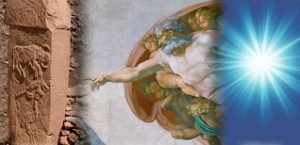
The reduction of the divine to human environment
It is possible to deny the existence of God, the argument of the evidence is naive, being neither logical as some modern rationalists wanted, nor human as some German idealists wanted and nor ontological as presented by Saint Anselm.
argument of the evidence is naive, being neither logical as some modern rationalists wanted, nor human as some German idealists wanted and nor ontological as presented by Saint Anselm.
There is a truth that comes from Socrates that says that it is not with men, but among men, this means that it is both ontological and complex at the same time, and one can not deny the historical existence of Jesus, whether by his historical birth at a time when sense was obligatory, for this was born in Bethlehem, and the record of his death and crucifixion which is told by historians of the time, including Josephus and by Jewish historiography.
But what Nietzsche, born in a family of Lutheran religious has seen beyond his time, is a philosophical and historical evidence of the death of God, through his human epiphany through the historical figure of Jesus, at least to Christianity, while God can be thought of innumerable eschatologies present in almost every culture so as not to be exhaustive, for even the so-called barbarian peoples had some form of divinity.
But the cry of Nietzsche’s madman is the realization of the construction of idealist and positivist philosophy that he wished to take as a single discourse on reality, Thomas Aquinas and other medievals were realistic as a philosophical current, now has a dark sunset.
From this isolationist, individualistic and separatist philosophy of the world three forms of collective heresies follow: a merely human God, a purely divine God, and a total absence of the third divine person: the Holy Spirit, for whom there is no forgiveness.
This sin is not the mere denial of God, but its concrete negation is the negation of the Other. Teilhard Chardin says about the inclusion of the Other that this is the “divine medium”, the typical mystique of our time, which can also be expressed as “where two or more are in my name” (Mt 18:20), which is a “and you who say that I am” (Mt 16:15), which follows several passages of the relationship with the World and with God.
One can say that there are two reductions: the merely human and the merely divine, but the main reduction is the ignorance of a third reduction which is that of the action of the Holy Spirit. In the reduction of the divine, Jesus in miracles almost always asked for a description or made allusion to the faith of the healed, the gifted or just the wonder of contact like the blind Bartimaeus, the prophet Ana, Simeon, the paralytics, lepers or the woman to whom he directs word.
True eschatology sees not only principle or end, but both in relation to the daily life of human life, Teilhard Chardin makes reflection in the book The divine medium (1957): “the slowly accumulated tension between Humanity and God will reach the limits fixed by the possibilities of the world, and then it will be the end … that we should expect not as a catastrophe but as a ‘surrender’ to the world to which we must collaborate with all our Christian forces without fear of the world, because their spells could no longer hurt those to whom he has become, beyond himself, the Body of him who is the One who comes.”
Like the evangelist Luke (Luke 9:20), Matthew also repeats Jesus’ question to the disciples, Mt 16:15: “But who do you say that I am?”
CHARDIN, T. O meio divino (The Divine medium: Essay of inner life). Lisbon: 1957. (in portuguese).









